Table of Contents
Cell Wall Diagram, Types, Structure, Functions
In this article we will discuss about cell wall diagram, types, structure and functions
Cell wall definition
- A cell wall is a structural non-living outer layer that surrounds some types of cells, situated outside the cell membrane.
- It can be tough, flexible and rigid which provides cell with both structural support and protection.
Types of cell wall
On the basis of chemical composition there are three types of cell wall
- Bacterial cell wall : made up of mucopeptide and muramic acid.
- Fungal cell wall: made up of chitin.
- Plant cell wall: made up of cellulose.
Also Read: Difference Between Cell Wall and Cell Membrane
Cell Wall Diagram
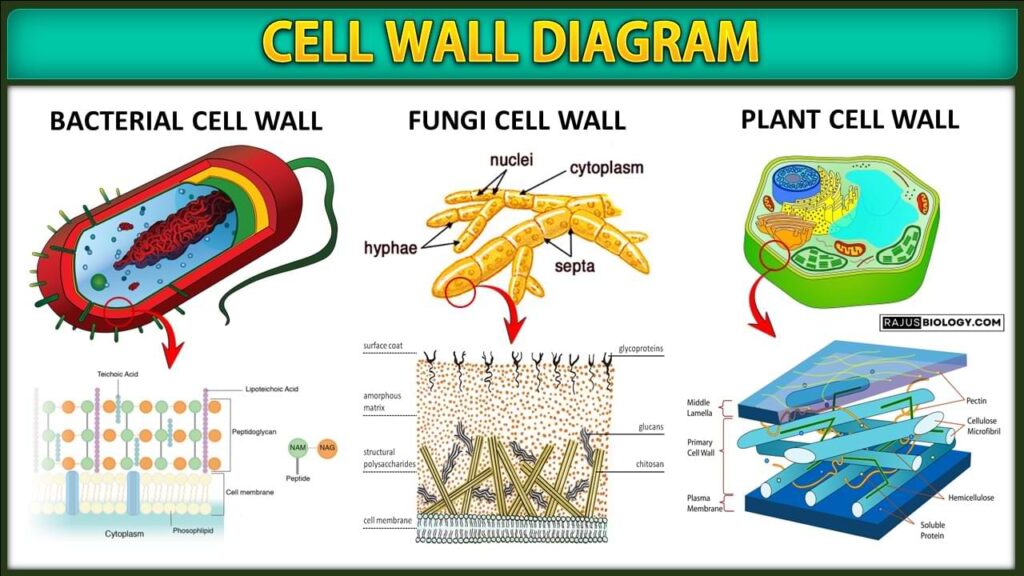
1. Bacterial cell wall
- The bacterial cell wall is a main component that provides structure and protection to bacterial cells.
- It acts as a semi-rigid barrier, preventing the cell from bursting under osmotic pressure and shielding it from various external stresses.
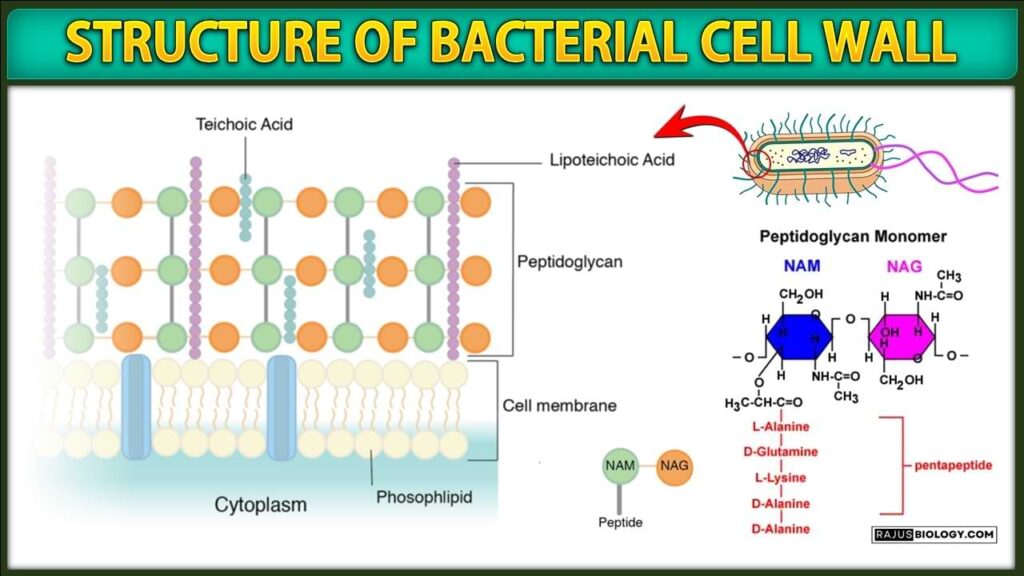
Structure of the bacterial cell wall
- The bacterial cell wall is primarily composed of peptidoglycan, also known as murein, is a polymer consisting of sugars and amino acids that forms a mesh like layer outside the cell membrane of most bacteria.
- The sugars component consist of alternating residues of β-(1,4) linked N- acetylglucosamine and N- acetylmuramic acid.
- These subunits which are related to glucose in their structure are covalently joined to one another to form glycan chains.
- Attached to the N- acetylmuramic acid is a peptide chain of three to five amino acids.
- The peptide chain can be cross linked to the peptide chain of another strand forming the peptidoglycan.
Types of bacterial cell wall
On the based structure of the cell wall and to their response to stain, bacterial cell wall have been classified into two types:
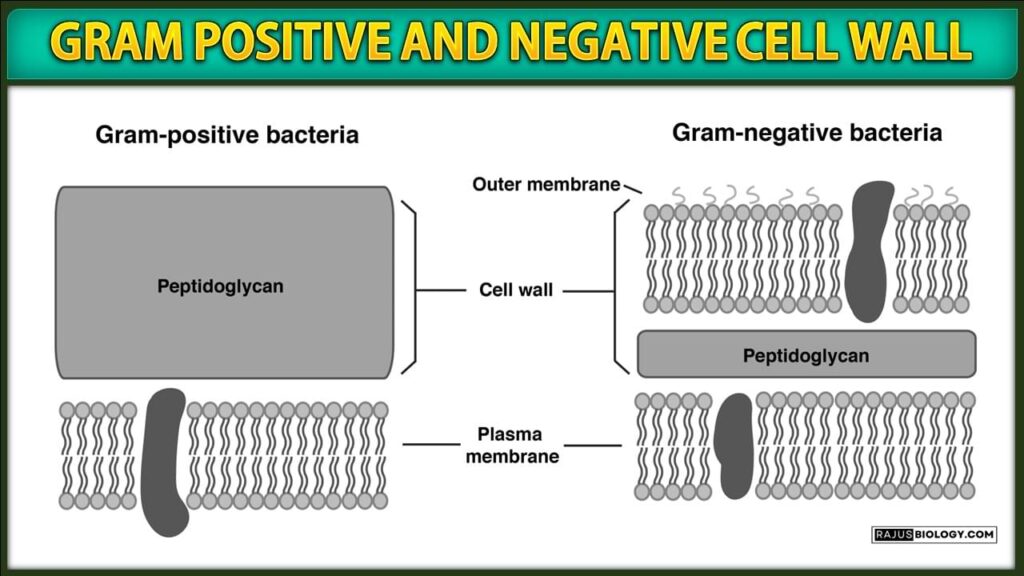
I. Gram positive cell wall
- Usually thick, homogenous, composed mainly of peptidoglycan.
- It accounts 50- 90% of the dry weight of the cell wall.
- Contain large amount of teichoic acids.
II. Gram negative cell wall
- Multi layered and more complex than gram positive cell walls.
- Peptidoglycan of gram negative bacteria is thin comprises only 10% or less of cell wall.
- Outer membrane lies outside the thin peptidoglycan layer.
- Most abundant protein is Braun’s lipoprotein.
Also Read: Difference Between Gram Positive and Gram Negative Bacteria
Functions of bacterial cell wall
- Provide rigidity to the cell, maintaining its shape and protecting it from physical damage.
- Acts as a semipermeable barrier, controling the influx or efflux of water and ions and protecting the cell from osmotic lysis.
- One of the main function is antibiotic resistance.
- The cell wall components, such as LPS in Gram-negative bacteria, can trigger immune responses and contribute to the virulence of pathogens.
- During cell replication, new peptidoglycan is synthesized, enabling the cell to divide into two daughter cells.
2. Fungal cell wall
- The fungal cell wall surrounds fungal cells, providing structural support and protection.
- It plays a crucial role in maintaining the shape and integrity of the fungal cell, as well as in interacting with the environment.
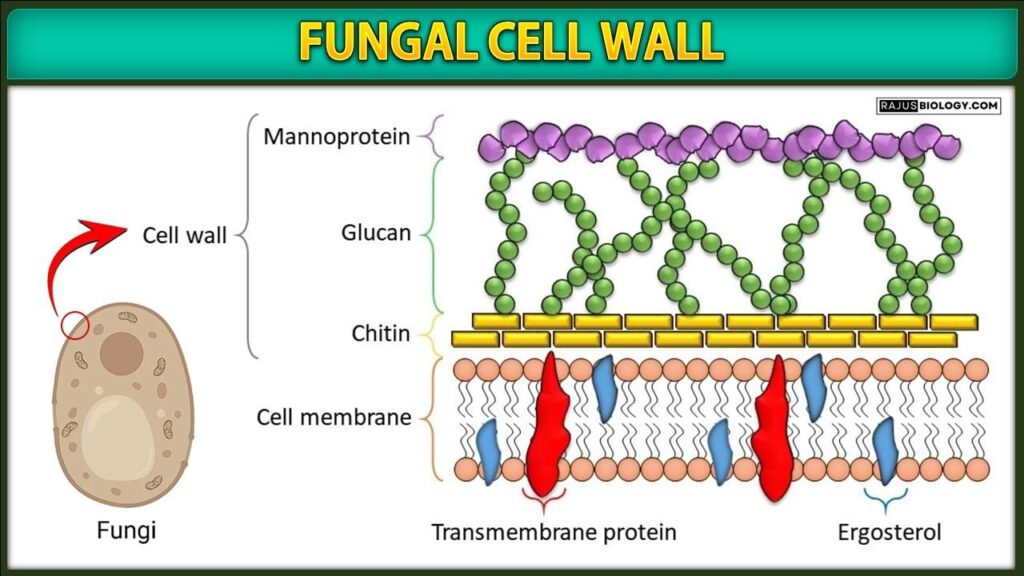
Structure of the fungal cell wall:
The fungal cell wall is multi-layered structure composed of various components like chitin (polymers of acetylated amino sugar N-acetylglucosamine), glucans and proteins
Chitin:
- It is primary structural component of the fungal cell wall.
- Made up of polymer of N-acetylglucosamine residues, which are linked together by β-1,4 glycosidic bonds.
- They forms a strong, rigid framework that provides strength and stability to the fungal cell wall.
Glucans:
- They are polysaccharides present in the fungal cell wall, including β-glucans and α-glucans.
- β-glucans are linear polymers of glucose molecules linked by β-1,3 or β-1,6 glycosidic bonds.
- α-glucans, such as glycogen and starch-like polysaccharides, are branched glucose polymers.
- These glucans help to the structural maintance of the cell wall.
Proteins:
- Proteins are components of the secondary wall.
- They are glycoproteins that are covalently attached to the fungal cell wall.
- It consist of a protein core with attached mannose-rich oligosaccharide chains.
- They help in cell adhesion, cell wall flexibility, and evasion of the host immune system.
- Other components include chitosan, melanins and lipids.
Functions of the fungal cell wall:
- It provides rigidity and shape to fungal cells.
- They acts as a physical barrier, protecting fungal cells from environmental stresses, such as osmotic changes, mechanical damage, and host immune responses.
- The cell wall contains transporters and enzymes that facilitate the uptake and metabolism of nutrients, including sugars, amino acids, and ions.
- Help in cell adhesion, biofilm formation, and hyphal fusion, enabling fungal cells to interact and communicate with each other.
- Acts as a molecular sieve.
- Contains pigments for protection.
- Binding sites for enzymes.
3. Plant Cell Wall
- The plant cell wall is a remarkable structure.
- It provides the most significant difference between plant cells and other eukaryotic cells.
- The wall is rigid (up to many micrometers in thickness) and gives plant cells a very defined shape.
- It is a complex and dynamic structure that plays a crucial role in plant growth, development, and adaptation.
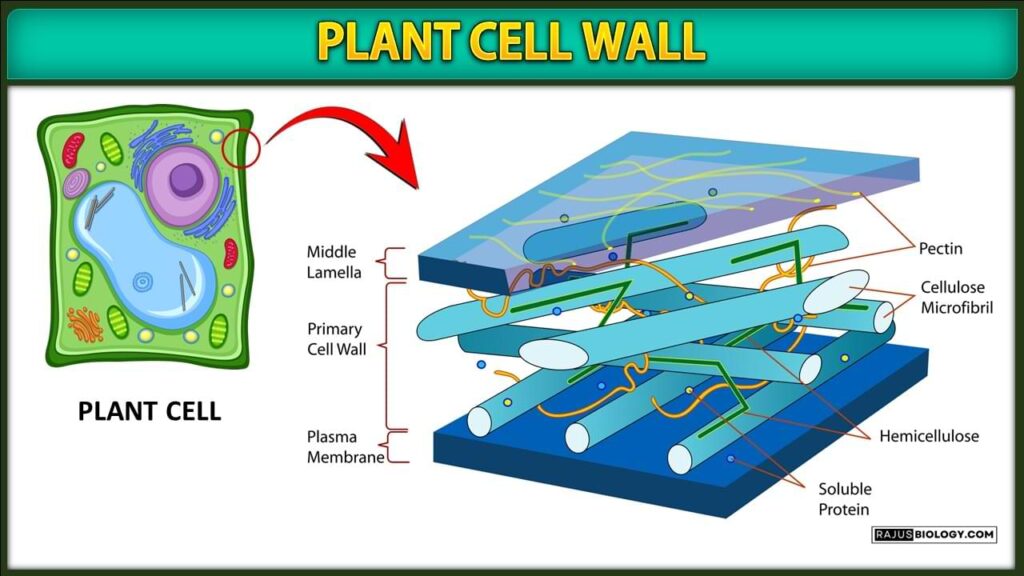
Structure of the plant cell wall
The major components of cell wall are cellulose,pectins, hemicelluloses, proteins and phenolics.
Cellulose
- It provides shape and strength to the cell wall.
- It is a linear polymer of glucose units linked by β-1,4 glycosidic bonds.
- It composes 20-30 % of the dry weight of primary wall and accounts 40-90% of the dry weight of secondary wall.
Pectins
- They are group of polysaccharides, which are rich in galacturonic acid, rhamnose, arabinose and galactose.
- Pectins are present in high concentration in the middle lamella where they presumably serve the function of cementing adjacent cells together.
Hemicelluloses
- It is a group of heterogeneous polysaccharides that surround cellulose microfibrils.
- It consists of various sugar units, such as glucose, xylose, mannose, and galactose.
- They differ in different species and in different cell types.
- Help to flexibility, water-holding capacity, and structural integrity of the cell wall.
Proteins
- Different varieties of protein are present in the cell wall, most of which are linked with carbohydrate forming glycoprotein.
- The cell wall glycoprotein extensin contains an unusual amino acid hydroxyproline (about 40%), which is generally absent from the protoplast.
- Extensins are present in the primary cell walls of dicots making up one to ten percent of the wall.
Types of plant cell walls:
Plant cell walls can be broadly categorized into primary and secondary cell walls, each with distinct characteristics and functions.
The Primary Cell Wall
- A thin, flexible and extensible layer.
- It is capable of growth and expansion.
- The backbone of primary cell wall is formed by the cellulose fibrils.
- The matrix is composed of hemicellulose, pectin compounds, lipids, structural proteins.
The Secondary Cell Wall
- It is extremely rigid and provides strength.
- It is not found in all cell types.
- It consists of three layers known as outer, middle and inner.
- It is composed of cellulose, hemicellulose and lignin.
Also Read: Difference Between Primary and Secondary Cell Wall
The Tertiary Cell Wall
- Tertiary cell wall is deposited in few cells.
- It is considered to be dry residue of protoplast .
- Besides cellulose and hemi-cellulose, xylan is also present.
Functions of the plant cell wall:
- It provides strength and rigidity to plant cells, help to maintain their shape and withstand mechanical forces.
- They protect the protoplasm from invasion by viral, bacterial and fungal pathogens.
- They are involved in the transport of materials and metabolites into and out of cell.
- The cell wall plays a crucial role in cell growth, cell division, tissue organization, and plant growth.
- They determine the morphology, growth and development of plant cells.
- They withstand the turgor pressure which develops within the cells due to high osmotic pressure.
FAQs
Who discovered cell wall?
In 1665, Robert Hooke discovered the cell wall. Later Schwann, a German physiologist, was the first scientist to propose that presence of a cell wall is a unique characteristic of all plant cells.
Do animal cells have a cell wall?
No, animal cells do not have a cell wall. Instead, animal cells are surrounded by a flexible cell membrane, also known as the plasma membrane. While the absence of a cell wall helps animal cells with greater flexibility and adaptability, it also makes them more susceptible to mechanical stress or changes in osmotic pressure.
Where is the cell wall located?
The cell wall is located outside the cell membrane in bacteria, fungi and plants. It acts as a protective barrier, giving cells their shape and structural integrity.
How does the cell wall protect a plant cell?
The plant cell wall work like a shield, providing physical protection from harmful microbes, maintaining cell shape and support, and regulating internal pressure.
Difference between cell wall and cell membrane?
The cell wall is a rigid structure located outside the cell membrane, providing support and protection to the cell, while the cell membrane is a thin, flexible barrier that encloses the cell and regulates the movement of substances in and out of the cell.
What is the nature of cell wall in diatoms?
Diatoms cell wall is made of unique structure called frustule, which is composed of silica (silicon dioxide). The frustule consists of two overlapping halves, like a soup box. The silica in the cell wall gives diatoms their characteristic glass like appearance.
What is the function of the cell wall?
The function of the cell wall in bacteria, fungi, and plants is to provide support, protection, and maintenance of cell shape.
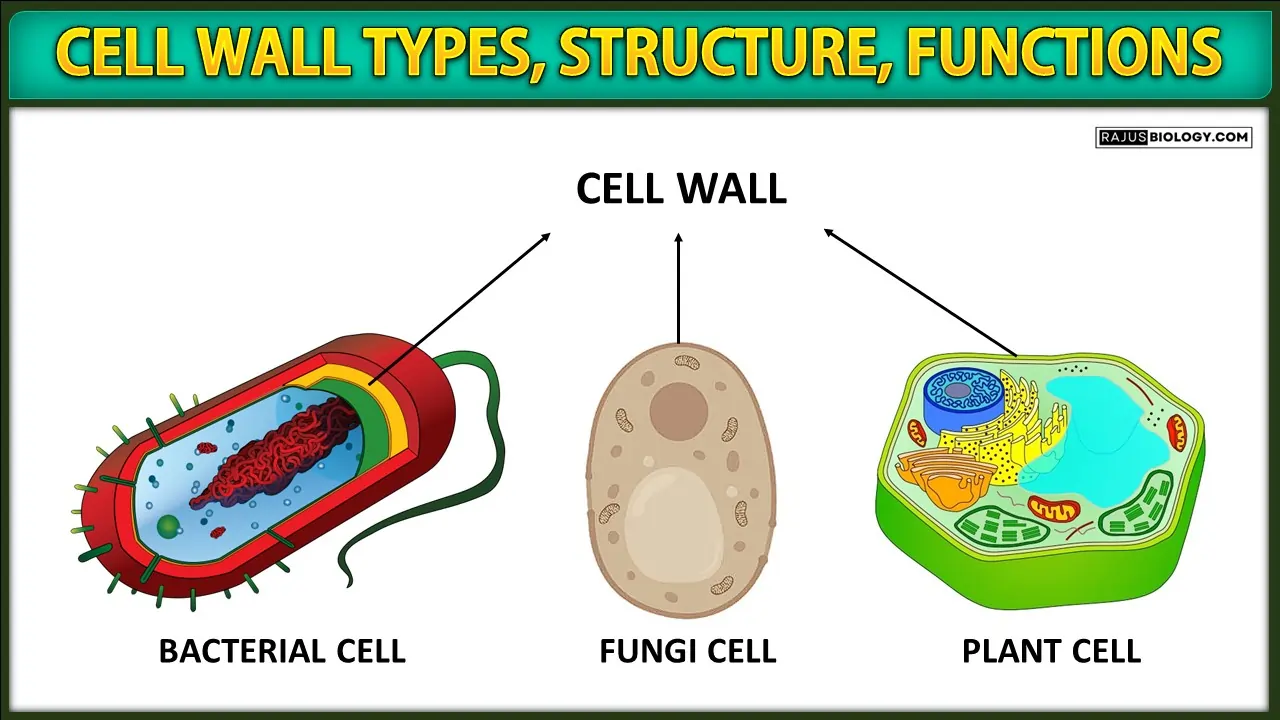


![[PPT] The living world Class 11 Notes](https://rajusbiology.com/wp-content/uploads/2024/06/PPT-The-living-world-Class-11-Notes-300x169.webp)
